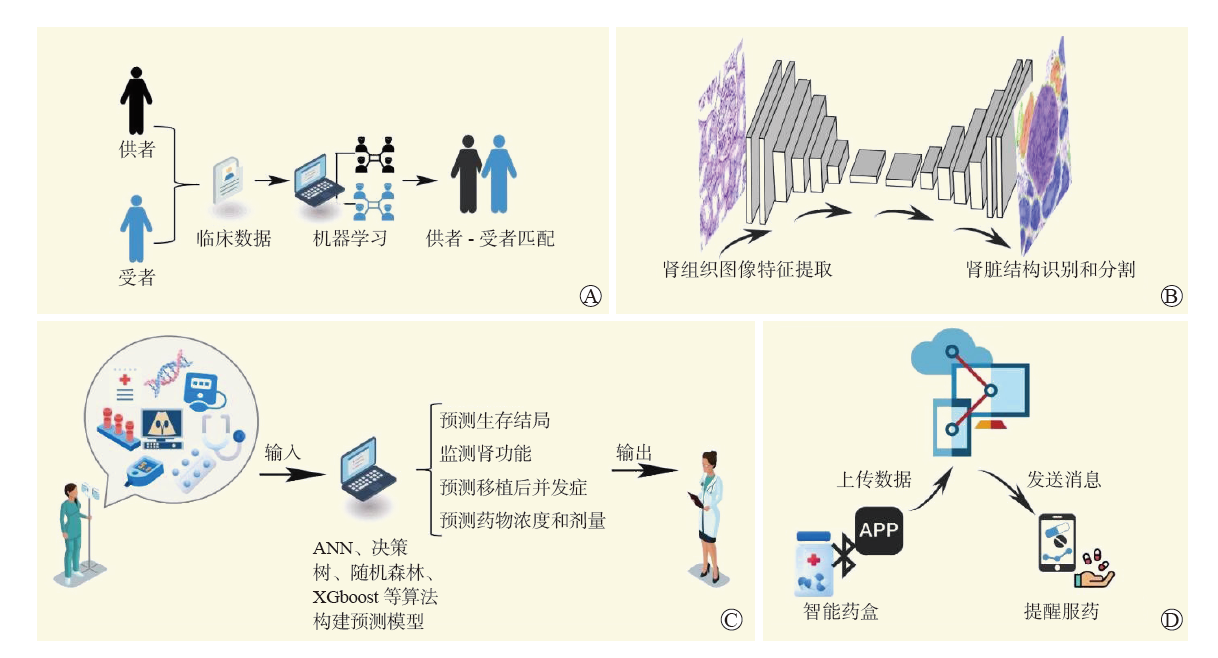| [1] |
JIANG F, JIANG Y, ZHI H, et al. Artificial intelligence in healthcare: past, present and future[J]. Stroke Vasc Neurol, 2017, 2(4): 230-243. DOI: 10.1136/svn-2017-000101.
|
| [2] |
邵琨, 王祥慧. 2020年肾移植临床国际前沿热点及新进展荟萃[J]. 器官移植, 2021, 12(2): 155-168. DOI: 10.3969/j.issn.1674-7445.2021.02.005.SHAO K, WANG XH. Highlights of international frontier hot spots and new progress on renal transplantation in 2020[J]. Organ Transplant, 2021, 12(2): 155-168. DOI: 10.3969/j.issn.1674-7445.2021.02.005.
|
| [3] |
LENTINE KL, SMITH JM, HART A, et al. OPTN/SRTR 2020 annual data report: kidney[J]. Am J Transplant, 2022, 22(Suppl 2): 21-136. DOI: 10.1111/ajt.16982.
|
| [4] |
SEYAHI N, OZCAN SG. Artificial intelligence and kidney transplantation[J]. World J Transplant, 2021, 11(7): 277-289. DOI: 10.5500/wjt.v11.i7.277.
|
| [5] |
COOREY CP, SHARMA A, MULLER S, et al. Prediction modeling-part 2: using machine learning strategies to improve transplantation outcomes[J]. Kidney Int, 2021, 99(4): 817-823. DOI: 10.1016/j.kint.2020.08.026.
|
| [6] |
TADDEO M, FLORIDI L. How AI can be a force for good[J]. Science, 2018, 361(6404): 751-752. DOI: 10.1126/science.aat5991.
|
| [7] |
GREENER JG, KANDATHIL SM, MOFFAT L, et al. A guide to machine learning for biologists[J]. Nat Rev Mol Cell Biol, 2022, 23(1): 40-55. DOI: 10.1038/s41580-021-00407-0.
|
| [8] |
LECUN Y, BENGIO Y, HINTON G. Deep learning[J]. Nature, 2015, 521(7553): 436-444. DOI: 10.1038/nature14539.
|
| [9] |
CHOI RY, COYNER AS, KALPATHY-CRAMER J, et al. Introduction to machine learning, neural networks, and deep learning[J]. Transl Vis Sci Technol, 2020, 9(2): 14. DOI: 10.1167/tvst.9.2.14.
|
| [10] |
BINI SA. Artificial intelligence, machine learning, deep learning, and cognitive computing: what do these terms mean and how will they impact health care?[J]. J Arthroplasty, 2018, 33(8): 2358-2361. DOI: 10.1016/j.arth.2018.02.067.
|
| [11] |
RAZZAQ M, CLÉMENT F, YVINEC R. An overview of deep learning applications in precocious puberty and thyroid dysfunction[J]. Front Endocrinol (Lausanne), 2022, 13: 959546. DOI: 10.3389/fendo.2022.959546.
|
| [12] |
PLACONA AM, MARTINEZ C, MCGEHEE H, et al. Can donor narratives yield insights? a natural language processing proof of concept to facilitate kidney allocation[J]. Am J Transplant, 2020, 20(4): 1095-1104. DOI: 10.1111/ajt.15705.
|
| [13] |
HAMOUDA E, EL-METWALLY S, TAREK M. Ant lion optimization algorithm for kidney exchanges[J]. PLoS One, 2018, 13(5): e0196707. DOI: 10.1371/journal.pone.0196707.
|
| [14] |
RASHIDI KHAZAEE P, BAGHERZADEH J, NIAZKHANI Z, et al. A dynamic model for predicting graft function in kidney recipients' upcoming follow up visits: a clinical application of artificial neural network[J]. Int J Med Inform, 2018, 119: 125-133. DOI: 10.1016/j.ijmedinf.2018.09.012.
|
| [15] |
VAN LOON E, ZHANG W, COEMANS M, et al. Forecasting of patient-specific kidney transplant function with a sequence-to-sequence deep learning model[J]. JAMA Netw Open, 2021, 4(12): e2141617. DOI: 10.1001/jamanetworkopen.2021.41617.
|
| [16] |
IMPROTA G, MAZZELLA V, VECCHIONE D, et al. Fuzzy logic-based clinical decision support system for the evaluation of renal function in post-transplant patients[J]. J Eval Clin Pract, 2020, 26(4): 1224-1234. DOI: 10.1111/jep.13302.
|
| [17] |
ACS B, RANTALAINEN M, HARTMAN J. Artificial intelligence as the next step towards precision pathology[J]. J Intern Med, 2020, 288(1): 62-81. DOI: 10.1111/joim.13030.
|
| [18] |
XIE Q, FAUST K, VAN OMMEREN R, et al. Deep learning for image analysis: personalizing medicine closer to the point of care[J]. Crit Rev Clin Lab Sci, 2019, 56(1): 61-73. DOI: 10.1080/10408363.2018.1536111.
|
| [19] |
MARSH JN, MATLOCK MK, KUDOSE S, et al. Deep learning global glomerulosclerosis in transplant kidney frozen sections[J]. IEEE Trans Med Imaging, 2018, 37(12): 2718-2728. DOI: 10.1109/TMI.2018.2851150.
|
| [20] |
HERMSEN M, DE BEL T, DEN BOER M, et al. Deep learning-based histopathologic assessment of kidney tissue[J]. J Am Soc Nephrol, 2019, 30(10): 1968-1979. DOI: 10.1681/ASN.2019020144.
|
| [21] |
SALVI M, MOGETTA A, GAMBELLA A, et al. Automated assessment of glomerulosclerosis and tubular atrophy using deep learning[J]. Comput Med Imaging Graph, 2021, 90: 101930. DOI: 10.1016/j.compmedimag.2021.101930.
|
| [22] |
YI Z, SALEM F, MENON MC, et al. Deep learning identified pathological abnormalities predictive of graft loss in kidney transplant biopsies[J]. Kidney Int, 2022, 101(2): 288-298. DOI: 10.1016/j.kint.2021.09.028.
|
| [23] |
FARRIS AB, VIZCARRA J, AMGAD M, et al. Image analysis pipeline for renal allograft evaluation and fibrosis quantification[J]. Kidney Int Rep, 2021, 6(7): 1878-1887. DOI: 10.1016/j.ekir.2021.04.019.
|
| [24] |
BROWN TS, ELSTER EA, STEVENS K, et al. Bayesian modeling of pretransplant variables accurately predicts kidney graft survival[J]. Am J Nephrol, 2012, 36(6): 561-569. DOI: 10.1159/000345552.
|
| [25] |
YOO KD, NOH J, LEE H, et al. A machine learning approach using survival statistics to predict graft survival in kidney transplant recipients: a multicenter cohort study[J]. Sci Rep, 2017, 7(1): 8904. DOI: 10.1038/s41598-017-08008-8.
|
| [26] |
BAE S, MASSIE AB, THOMAS AG, et al. Who can tolerate a marginal kidney? predicting survival after deceased donor kidney transplant by donor-recipient combination[J]. Am J Transplant, 2019, 19(2): 425-433. DOI: 10.1111/ajt.14978.
|
| [27] |
RAYNAUD M, AUBERT O, DIVARD G, et al. Dynamic prediction of renal survival among deeply phenotyped kidney transplant recipients using artificial intelligence: an observational, international, multicohort study[J]. Lancet Digit Health, 2021, 3(12): e795-e805. DOI: 10.1016/S2589-7500(21)00209-0.
|
| [28] |
NAQVI SAA, TENNANKORE K, VINSON A, et al. Predicting kidney graft survival using machine learning methods: prediction model development and feature significance analysis study[J]. J Med Internet Res, 2021, 23(8): e26843. DOI: 10.2196/26843.
|
| [29] |
梁诚, 牛纪平, 满江位, 等. 管周毛细血管损伤在肾移植中作用的研究进展[J]. 器官移植, 2023, 14(1): 147-153. DOI: 10.3969/j.issn.1674-7445.2023.01.020.LIANG C, NIU JP, MAN JW, et al. Progress in the role of peritubular capillary injury in kidney transplantation[J]. Organ Transplant, 2023, 14(1): 147-153. DOI: 10.3969/j.issn.1674-7445.2023.01.020.
|
| [30] |
KIM YG, CHOI G, GO H, et al. A fully automated system using a convolutional neural network to predict renal allograft rejection: extra-validation with giga-pixel immunostained slides[J]. Sci Rep, 2019, 9(1): 5123. DOI: 10.1038/s41598-019-41479-5.
|
| [31] |
ABDELTAWAB H, SHEHATA M, SHALABY A, et al. A novel CNN-based CAD system for early assessment of transplanted kidney dysfunction[J]. Sci Rep, 2019, 9(1): 5948. DOI: 10.1038/s41598-019-42431-3.
|
| [32] |
SHEHATA M, SHALABY A, SWITALA AE, et al. A multimodal computer-aided diagnostic system for precise identification of renal allograft rejection: preliminary results[J]. Med Phys, 2020, 47(6): 2427-2440. DOI: 10.1002/mp.14109.
|
| [33] |
FU Q, AGARWAL D, DENG K, et al. An unbiased machine learning exploration reveals gene sets predictive of allograft tolerance after kidney transplantation[J]. Front Immunol, 2021, 12: 695806. DOI: 10.3389/fimmu.2021.695806.
|
| [34] |
WANG Y, ZHANG D, HU X. A three-gene peripheral blood potential diagnosis signature for acute rejection in renal transplantation[J]. Front Mol Biosci, 2021, 8: 661661. DOI: 10.3389/fmolb.2021.661661.
|
| [35] |
PONTRELLI P, SIMONE S, RASCIO F, et al. Pre-transplant expression of CCR-2 in kidney transplant recipients is associated with the development of delayed graft function[J]. Front Immunol, 2022, 13: 804762. DOI: 10.3389/fimmu.2022.804762.
|
| [36] |
KONIECZNY A, STOJANOWSKI J, RYDZYŃSKA K, et al. Artificial intelligence-a tool for risk assessment of delayed-graft function in kidney transplant[J]. J Clin Med, 2021, 10(22): 5244. DOI: 10.3390/jcm10225244.
|
| [37] |
JEN KY, ALBAHRA S, YEN F, et al. Automated en masse machine learning model generation shows comparable performance as classic regression models for predicting delayed graft function in renal allografts[J]. Transplantation, 2021, 105(12): 2646-2654. DOI: 10.1097/TP.0000000000003640.
|
| [38] |
COSTA SD, DE ANDRADE LGM, BARROSO FVC, et al. The impact of deceased donor maintenance on delayed kidney allograft function: a machine learning analysis[J]. PLoS One, 2020, 15(2): e0228597. DOI: 10.1371/journal.pone.0228597.
|
| [39] |
KAWAKITA S, BEAUMONT JL, JUCAUD V, et al. Personalized prediction of delayed graft function for recipients of deceased donor kidney transplants with machine learning[J]. Sci Rep, 2020, 10(1): 18409. DOI: 10.1038/s41598-020-75473-z.
|
| [40] |
PENG B, GONG H, TIAN H, et al. The study of the association between immune monitoring and pneumonia in kidney transplant recipients through machine learning models[J]. J Transl Med, 2020, 18(1): 370. DOI: 10.1186/s12967-020-02542-2.
|
| [41] |
LUO Y, TANG Z, HU X, et al. Machine learning for the prediction of severe pneumonia during posttransplant hospitalization in recipients of a deceased-donor kidney transplant[J]. Ann Transl Med, 2020, 8(4): 82. DOI: 10.21037/atm.2020.01.09.
|
| [42] |
XIA M, YANG H, TONG X, et al. Risk factors for new-onset diabetes mellitus after kidney transplantation: a systematic review and meta-analysis[J]. J Diabetes Investig, 2021, 12(1): 109-122. DOI: 10.1111/jdi.13317.
|
| [43] |
KIM JE, PARK SJ, KIM YC, et al. Deep learning-based quantification of visceral fat volumes predicts posttransplant diabetes mellitus in kidney transplant recipients[J]. Front Med (Lausanne), 2021, 8: 632097. DOI: 10.3389/fmed.2021.632097.
|
| [44] |
AL-IMAM A, AL-TABBAKH ALI. Predictors of new-onset diabetes after kidney transplantation during 2019-nCoV pandemic: a unison of frequentist inference and narrow AI[J]. Open Access Maced J Med Sci, 2022, 10(B): 180-191. DOI: 10.3889/oamjms.2022.7521.
|
| [45] |
詹世鹏, 马攀, 刘芳. 机器学习在治疗药物监测与个体化用药中的应用[J]. 中国药房, 2023, 34(1): 117-121, 128. DOI: 10.6039/j.issn.1001-0408.2023.01.23.ZHAN SP, MA P, LIU F. Application of machine learning in the therapeutic drug monitoring and individual drug therapy[J]. China Pharm, 2023, 34(1): 117-121, 128. DOI: 10.6039/j.issn.1001-0408.2023.01.23.
|
| [46] |
MAO J, CHEN Y, XU L, et al. Applying machine learning to the pharmacokinetic modeling of cyclosporine in adult renal transplant recipients: a multi-method comparison[J]. Front Pharmacol, 2022, 13: 1016399. DOI: 10.3389/fphar.2022.1016399.
|
| [47] |
WOILLARD JB, LABRIFFE M, DEBORD J, et al. Tacrolimus exposure prediction using machine learning[J]. Clin Pharmacol Ther, 2021, 110(2): 361-369. DOI: 10.1002/cpt.2123.
|
| [48] |
LABRIFFE M, WOILLARD JB, DEBORD J, et al. Machine learning algorithms to estimate everolimus exposure trained on simulated and patient pharmacokinetic profiles[J]. CPT Pharmacometrics Syst Pharmacol, 2022, 11(8): 1018-1028. DOI: 10.1002/psp4.12810.
|
| [49] |
彭怀东, 杨灿邦, 张磊, 等. 多重用药的肾移植受者用药现状与药学服务需求调查[J]. 中国医院药学杂志, 2022, 42(12): 1276-1281, 1292. DOI: 10.13286/j.1001-5213.2022.12.19.PENG HD, YANG CB, ZHANG L, et al. A questionnaire for prescription pattern and pharmaceutical care needs on renal transplant recipients with polypharmacy[J]. Chin J Hosp Pharm, 2022, 42(12): 1276-1281, 1292. DOI: 10.13286/j.1001-5213.2022.12.19.
|
| [50] |
MCGILLICUDDY J, CHANDLER J, SOX L, et al. "Smartphone medication adherence saves kidneys" for kidney transplantation recipients: protocol for a randomized controlled trial[J]. JMIR Res Protoc, 2019, 8(6): e13351. DOI: 10.2196/13351.
|
| [51] |
FLEMING JN, GEBREGZIABHER M, POSADAS A, et al. Impact of a pharmacist-led, mHealth-based intervention on tacrolimus trough variability in kidney transplant recipients: a report from the TRANSAFE Rx randomized controlled trial[J]. Am J Health Syst Pharm, 2021, 78(14): 1287-1293. DOI: 10.1093/ajhp/zxab157.
|
| [52] |
HAN A, MIN SI, AHN S, et al. Mobile medication manager application to improve adherence with immunosuppressive therapy in renal transplant recipients: a randomized controlled trial[J]. PLoS One, 2019, 14(11): e0224595. DOI: 10.1371/journal.pone.0224595.
|
| [53] |
MAGRABI F, AMMENWERTH E, MCNAIR JB, et al. Artificial intelligence in clinical decision support: challenges for evaluating AI and practical implications[J]. Yearb Med Inform, 2019, 28(1): 128-134. DOI: 10.1055/s-0039-1677903.
|
| [54] |
MAHADEVAIAH G, RV P, BERMEJO I, et al. Artificial intelligence-based clinical decision support in modern medical physics: selection, acceptance, commissioning, and quality assurance[J]. Med Phys, 2020, 47(5): e228-e235. DOI: 10.1002/mp.13562.
|
| [55] |
GIANFRANCESCO MA, TAMANG S, YAZDANY J, et al. Potential biases in machine learning algorithms using electronic health record data[J]. JAMA Intern Med, 2018, 178(11): 1544-1547. DOI: 10.1001/jamainternmed.2018.3763.
|
| [56] |
KELLY CJ, KARTHIKESALINGAM A, SULEYMAN M, et al. Key challenges for delivering clinical impact with artificial intelligence[J]. BMC Med, 2019, 17(1): 195. DOI: 10.1186/s12916-019-1426-2.
|
| [57] |
BRIGANTI G, LE MOINE O. Artificial intelligence in medicine: today and tomorrow[J]. Front Med (Lausanne), 2020, 7: 27. DOI: 10.3389/fmed.2020.00027.
|
| [58] |
张姝艳, 皮婷婷. 医疗领域中人工智能应用的可解释性困境与治理[J]. 医学与哲学, 2023, 44(3): 25-29, 35. DOI: 10.12014/j.issn.1002-0772.2023.03.06.ZHANG SY, PI TT. Interpretability dilemma and governance of artificial intelligence application in medical field[J]. Med Philos, 2023, 44(3): 25-29, 35. DOI: 10.12014/j.issn.1002-0772.2023.03.06.
|
| [59] |
王涵, 陈敏. 医疗人工智能政策法律分析及对策研究[J]. 中国数字医学, 2021, 16(12): 73-77. DOI: 10.3969/j.issn.1673-7571.2021.12.017.WANG H, CHEN M. Policy and law analysis and countermeasures research of medical artificial intelligence[J]. China Digit Med, 2021, 16(12): 73-77. DOI: 10.3969/j.issn.1673-7571.2021.12.017.
|
| [60] |
郑志峰. 诊疗人工智能的医疗损害责任[J]. 中国法学, 2023(1): 203-221. DOI: 10.14111/j.cnki.zgfx.2023.01.011.ZHENG ZF. Liability for medical damage caused by diagnostic and therapeutic artificial intelligence[J]. China Legal Sci, 2023(1): 203-221. DOI: 10.14111/j.cnki.zgfx.2023.01.011.
|





 下载:
下载:






